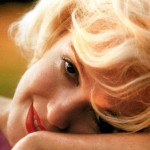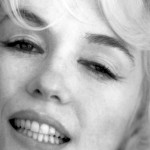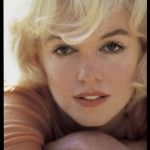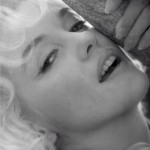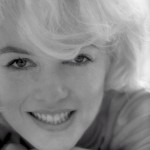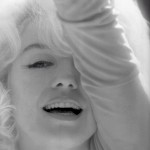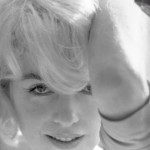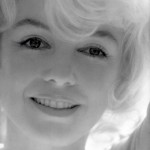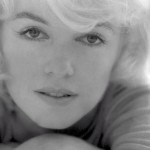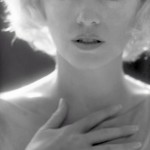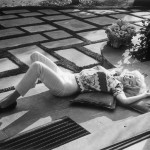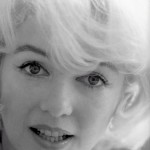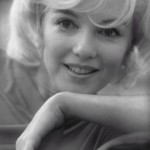1962
Willy Rizzo, the renowned photographer with a career spanning over six decades, and one of the last photographers to shoot Marilyn in the months before she died was born in Naples, Italy in 1929 and went on to spend his childhood in France. His passion for photography began early, when at the Italian college of Sédillot he first began taking photographs of his classmates with the Agfa Box camera given to him as a gift by his mother.
When he began his career in the early 1940’s just as the trend of photojournalism was first beginning to blossom, he was one of the youngest photographers working in the field. He purchased his first camera, a black Rolleiflex, on the black market in 1944. His early accolades include photographic submissions for Ciné Mondial, Point du vue and Image du monde as well as covering the Nuremburg Trials beginning in 1945.
“First you’re happy to get the booking, then you’re happy taking the photos and then again when they’re published,” Rizzo says of his early years working in the industry. “For years you like looking at them over and over again until you forget about them, and finally rediscover them,” he says of the many and varied images he has captured throughout his career.
In 1946 he was sent to Cannes by the publication Dimanche to photograph the first film festival. Rizzo reaped golden results behind the camera, coming back with shots not only of the actors and actresses, but other notable members of society such as wealthy tycoons, socialites and royalty using a Zeiss Sonar 180. Dimanche were impressed with his results. With his career flourishing, the still young Rizzo was sent to the USA by British agency Black Star where he had the opportunities to shoot celebrities such as Edith Piaf, Gary Cooper, Anne Baxter, Richard Widmark and Gregory Peck.
His career continued to flourish throughout the 1950’s with him submitting his work to such publications as Vogue and Paris-Match. Throughout the 1960’s Rizzo’s work mainly focused on portraits, with none more famous than the shoot he did with Marilyn Monroe in February of 1962. At first the shoot was very much a ‘mission impossible’ affair, with a friend of Rizzo’s who was an acquaintance of Marilyn’s agent, Arthur P. Jacobs calling him to discuss organising a shoot.
Jacobs informed the friend that this request was ‘impossible’, and the message was relayed back to Rizzo, but determined he still hoped for a chance even though Marilyn was tied up in a number of personal affairs. These included moving house, her daily sessions with Dr Ralph Greenson, and also a pending trip to Mexico to – among other things – purchase furnishings for the new property she was relocating to on 5th Helena Drive, Brentwood. Eventually, contact was made with Rizzo’s friend once more from Jacobs, informing them that Marilyn had agreed to the shoot and to relay this message to Rizzo, who was ecstatic at the prospect of working with Monroe.
The meeting was not without its conditions, though. Firstly, Rizzo was refused his request to conduct the shoot in the morning when the light would be at its best. Jacobs was adamant this request was too much, and informed Rizzo that it was not possible. It had to be an afternoon shoot or nothing at all. Rizzo agreed, and the meet was set for two days later at a friend’s house. Rizzo waited and waited, but no Marilyn. He was called by Jacobs and told that she was not feeling well and would not be able to attend the shoot. Rizzo was dejected, but understood if Marilyn wasn’t feeling well, then she wasn’t feeling well and patiently waited for her at the same location the next day.
Again, he had a long wait until Marilyn breezed in at 6pm. Sadly for him; this was just for a face-to-face apology she felt Rizzo deserved. “I’m sorry, I’m so tired. I’ll be here tomorrow, I promise,” she told him kindly before honouring him a little kiss. This kiss melted Rizzo, and he told her fondly “For you, I would wait a week.” This was perhaps not the best thing to say to a woman who was renowned for her lateness (as she once said herself – “I’ve been on a calendar, but never on time!”) but true to her promise Marilyn arrived the next day when she said she would, and what would turn out to be one of the last ever professional photo shoot with the star commenced.
Rizzo commented that Marilyn had applied her makeup herself, and even though he honestly admitted that he thought she’d made ‘a bit of a hash of it’ (to use his very words), she was still luminous to his eyes and his lens. He commented that looking at her was like looking at all of the world’s most beautiful women at once, all rolled into one person. Rizzo also commented that he thought Marilyn had an air of underlying sadness about her. “I could sense how distraught she was at this last meeting, but we still took the photos. She trusted me, we knew each other and that is so important, trust is the most important thing of all,” Rizzo said of the shoot in an interview years after Marilyn’s death.
When one views the stunningly colourful and beautifully lit photographs from this shoot, the sadness Rizzo saw can be seen on close inspection (especially when you look into her beautiful eyes), but more than that they show Marilyn’s fresh innocence, which no amount of personal crisis or sadness could ever truly rob her of. Sure, she looks tired in these pictures, and when we take into account her busy schedule and other personal troubles at that very moment in time it is no surprise that she would be lethargic and perhaps not quite look her ‘red carpet’ best, but I personally think the Rizzo photographs show Marilyn in the light of a real person rather than a huge starlet.
There is something about the series of pictures that is very raw, very real, and at times uncomfortable to witness. They show Marilyn not as the sex goddess everyone has hyped her up to be, but the very real and often fragile woman she was. She looks almost ethereal in the pictures, a divine entity not of this world, and the light around her captured so beautifully by Rizzo she looked almost angelic. This writer and fan certainly hopes that among the treasures of his career, these photographs are remembered and rediscovered again fondly by him, as his other works are.
After his successful career as a photographer, Rizzo moved onto the career he is perhaps better known for: furniture design. His pieces, which range from sofas to coffee tables, from hi-fi cabinets to hutches, all have the simple yet practical designs to them, a contemporary and clean edge with a certain old feel cosiness, and after first furnishing a friends’ apartment, the orders for his designs flooded in thick and fast, even though this career was originally not one Rizzo sought. In fact, Rizzo is now more famous for his beautiful furnishings than his glittering photographic career, but just like the man himself said, the shoot he did with Marilyn Monroe is simply unforgettable.[/vc_column_text][/vc_column][/vc_row][vc_row][vc_column width=”1/1″][vc_column_text]



